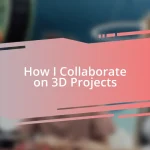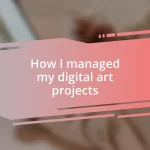Key takeaways:
- Define your art goals to better align your creative process and software choices with your personal expression and motivations.
- Evaluate software through free trials and demos, ensuring compatibility, performance, and an intuitive user interface that enhances your artistic flow.
- Make your final software decision based on emotional connection to the tools, practical compatibility, and the inspiration they provide for your creative vision.
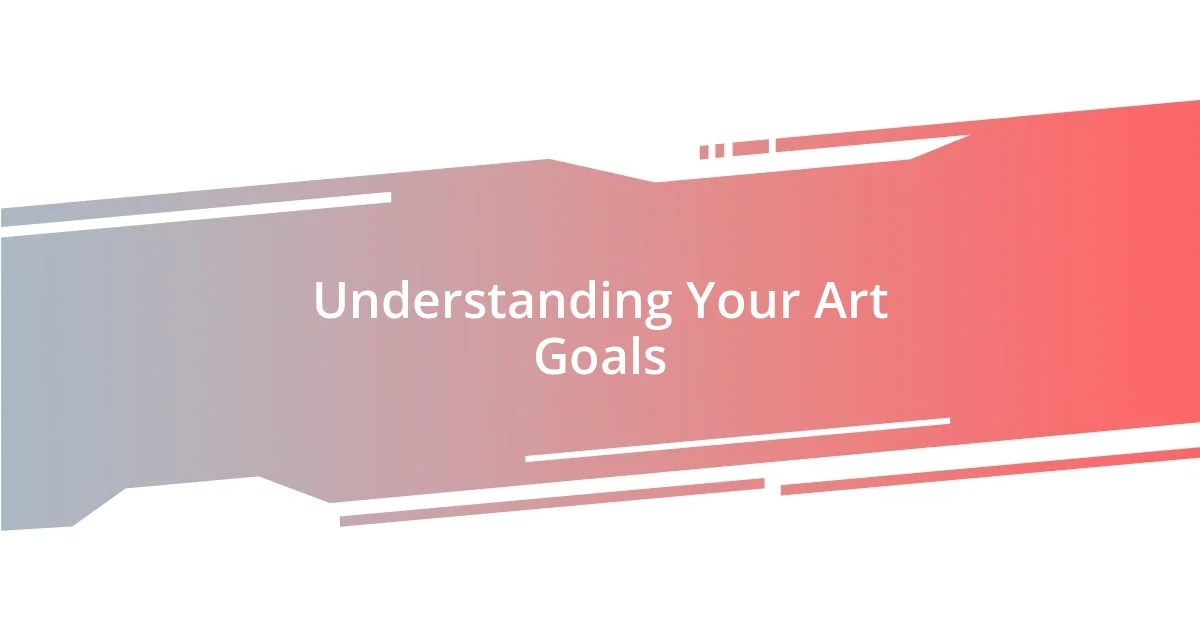
Understanding Your Art Goals
When I first started my artistic journey, I felt a bit lost. It was only after I took the time to define my goals—whether it was to create intricate digital paintings or simple sketches—that everything clicked into place. Have you ever felt that kind of uncertainty about where to direct your creativity?
Understanding your art goals isn’t just about knowing what you want to create; it’s about discovering why you want to create it. For me, art has always been a means of self-expression, a way to communicate emotions I sometimes struggle to articulate. Reflecting on your motivations can unveil deeper layers of inspiration that fuel your creativity.
As I experimented with different mediums, I often asked myself, “What do I want my art to say to the world?” This realization led me to embrace digital software that aligned with my storytelling aspirations. Connecting deeply with your art goals empowers you to choose tools that not only enhance your skills but resonate with your creative vision.
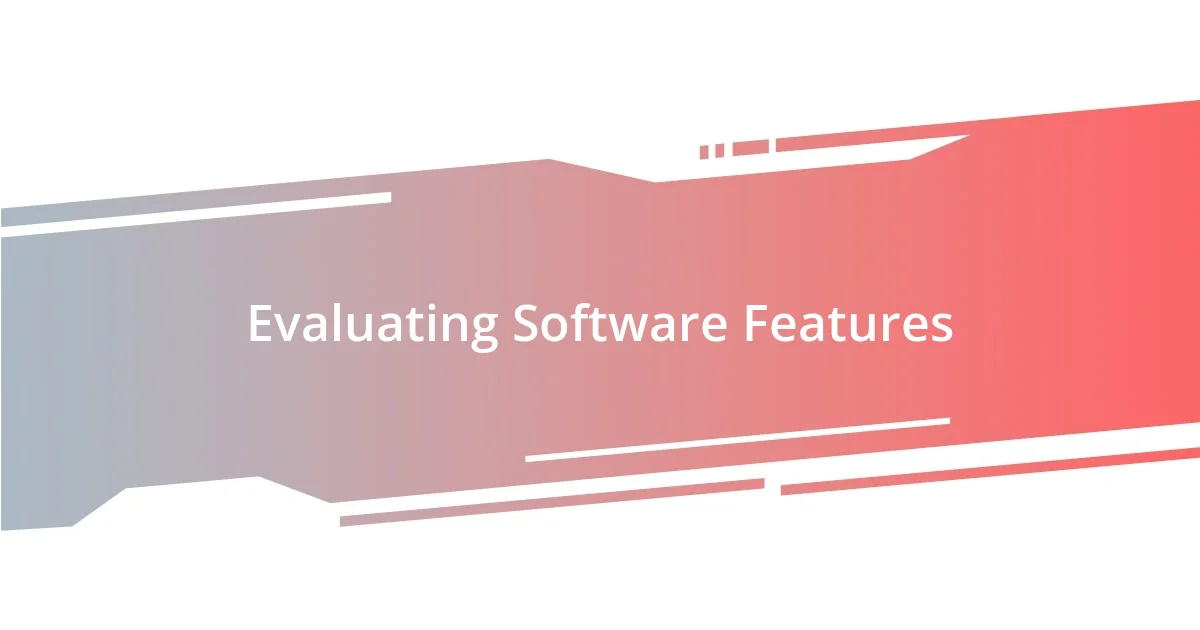
Evaluating Software Features
When I began evaluating software features, I realized it was vital to consider my specific needs as an artist. For instance, whether I leaned towards illustration, graphic design, or animation influenced the tools I wanted in my software. I still remember test-driving a few programs and feeling a rush of excitement when I discovered the precise brush settings in one software that allowed my strokes to mimic traditional painting.
Another critical aspect was the user interface. I had the chance to explore various options, and I learned that an intuitive interface can make or break the creative flow. One program that I initially dismissed due to its complexity suddenly clicked for me once I found a few well-organized tutorials. It was an eye-opener—true usability can empower creativity more than I had anticipated.
Performance and compatibility with my existing hardware were also paramount considerations. I recall being frustrated when a software I loved was sluggish on my tablet. After a few trials, I focused on lightweight options that still offered robust features. This approach not only brightened my artistic process but also allowed me to work seamlessly, which is a game-changer for productivity.
| Feature | Software A | Software B | Software C |
|---|---|---|---|
| Brush Customization | Extensive | Moderate | Limited |
| User Interface | Intuitive | Complex | Clean |
| Performance | High | Medium | Low |
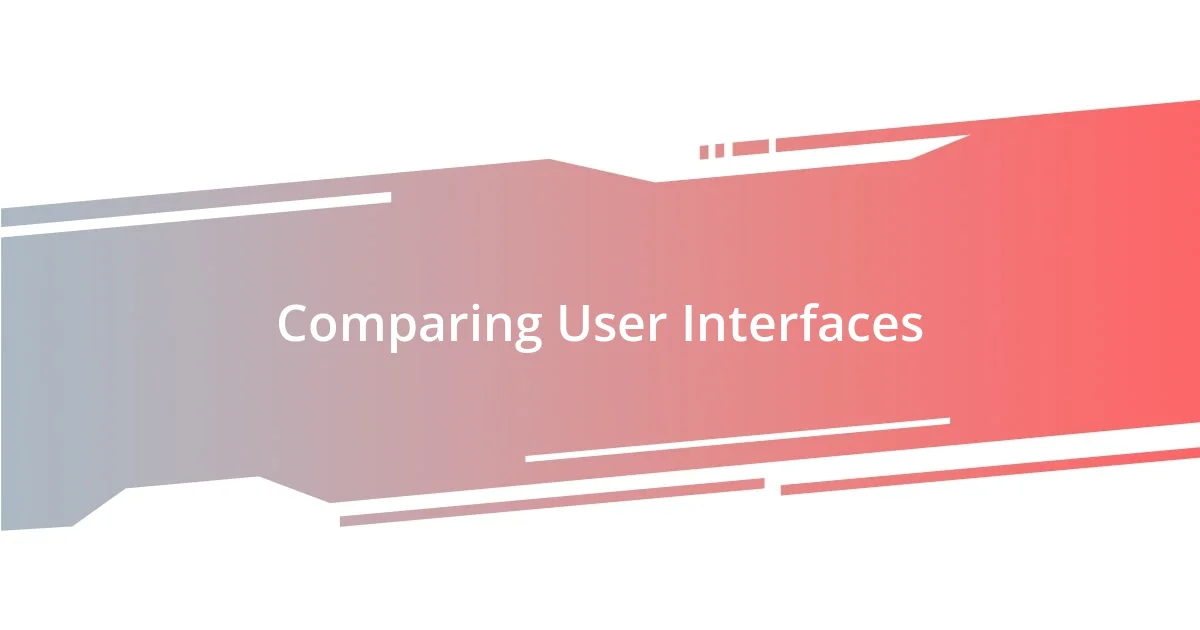
Comparing User Interfaces
When it comes to comparing user interfaces, I’ve found that the key is how they resonate with my creativity. Some interfaces felt immediately comfortable, like a familiar pair of shoes, while others were clunky and left me frustrated. I still remember downloading a highly recommended software whose interface looked sleek but left me puzzled. Navigating through a maze of icons, I lost precious time trying to understand where basic tools were hidden. This experience taught me that a clear, intuitive interface isn’t just a luxury; it’s essential for maintaining my artistic momentum.
Here are a few factors that I consider crucial when evaluating user interfaces:
- Intuitiveness: How easily can I access tools and features?
- Customization: Can I personalize the workspace to suit my workflow?
- Feedback: Does the interface provide helpful visual cues or guidance?
In my journey, I discovered that the more user-friendly the interface, the more I could focus on my art instead of struggling with the software. On the other hand, when an interface feels cluttered, it can turn the joy of creation into a chore. I encourage you to actively test out the platforms yourself; you’ll often find that the interface greatly influences not just your productivity, but also your enjoyment of the creative process.
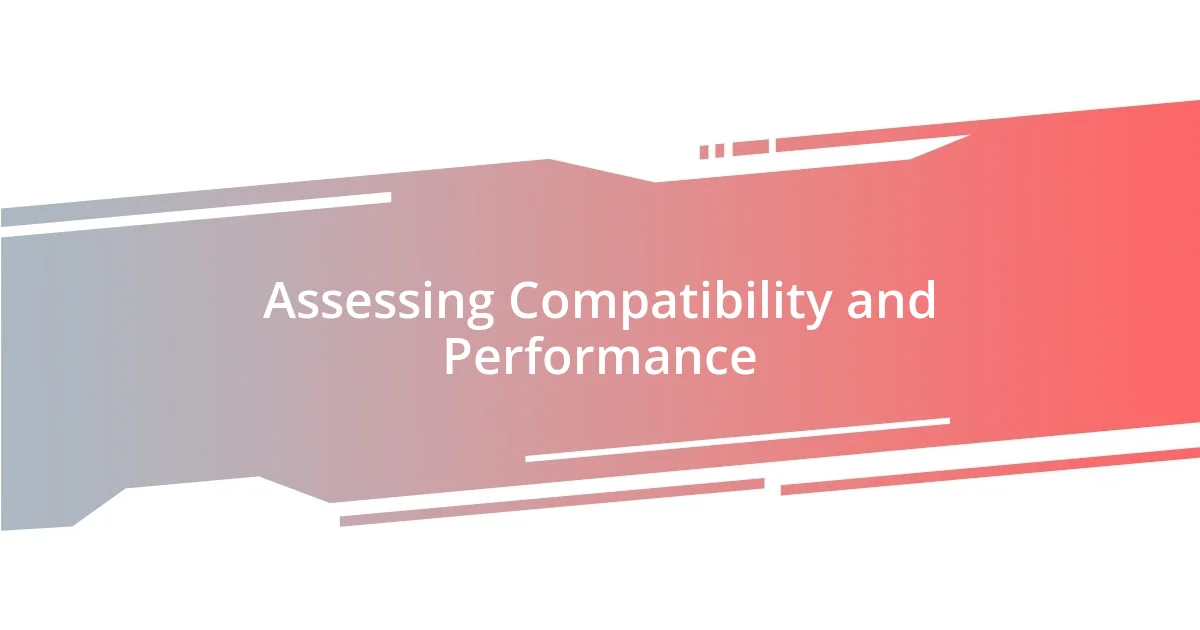
Assessing Compatibility and Performance
Assessing compatibility with my hardware was something I learned to prioritize early on. During my quest, I vividly remember downloading a program that, on paper, had all the features I dreamed of. But when I actually tried to use it, I found myself staring at a spinning wheel of doom—it was painfully slow. Have you ever felt that frustrating disconnect between what you want your software to do and what your device can handle? It’s a harsh wake-up call that prompted me to only consider programs that optimized performance without hogging resources.
Performance, for me, became a benchmark in deciding on art software. I had a stint where I was juggling multiple layers in a painting application, and to say it was lagging would be an understatement. The experience almost made me want to toss my tablet out the window! I realized that fluidity can enhance creativity, so I shifted my focus toward lighter software that still boasted powerful performance. This shift not only made me more productive but also turned frustration into exhilaration, allowing my artistry to flourish in a stress-free environment.
When it comes to testing software, I found that compatibility wasn’t just about the system requirements; it was about how well the program integrated into my existing workflow. I remember switching to a new drawing software, and while it ran smoothly, its file types were incompatible with my other projects. I had to spend hours converting files! It was then that I understood: assessing compatibility is not just a check in the box; it’s about ensuring a harmonious fit with all the tools I already use. After all, a great art software should enhance your capabilities, not complicate them!
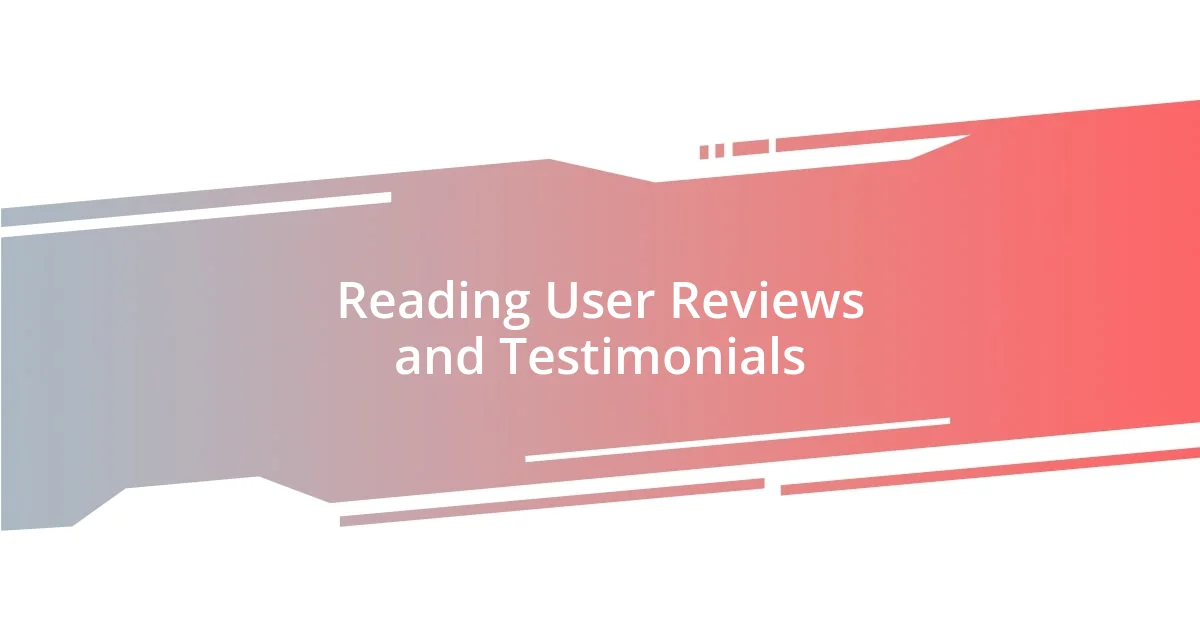
Reading User Reviews and Testimonials
Reading user reviews and testimonials has been a game changer for me. I recall sifting through countless reviews while contemplating a popular art software. One review stood out; it described how the author felt liberated after discovering a specific feature that aligned perfectly with their workflow. This sparked an idea in me—how many hidden gems are out there that others have unearthed?
I often look for patterns in reviews, especially when multiple users highlight similar pros or cons. A time I took notice was while researching a particular digital painting program; several artists mentioned the incredible brush customization options. Their authentic excitement made me curious, and I found myself diving deeper into demos and tutorials. It’s almost like hearing your friends rave about a restaurant—you can’t resist checking it out yourself!
Engaging with testimonials helps me bridge the gap between my own experience and that of other users. I once read a testimonial from an artist who shared their struggles with a program’s steep learning curve. They wrote about their eventual breakthrough and how rewarding it felt, which resonated with my own journey of wrestling with new software. It reminded me that behind every review is a story, and those shared experiences can often help lead me to the right tools faster.
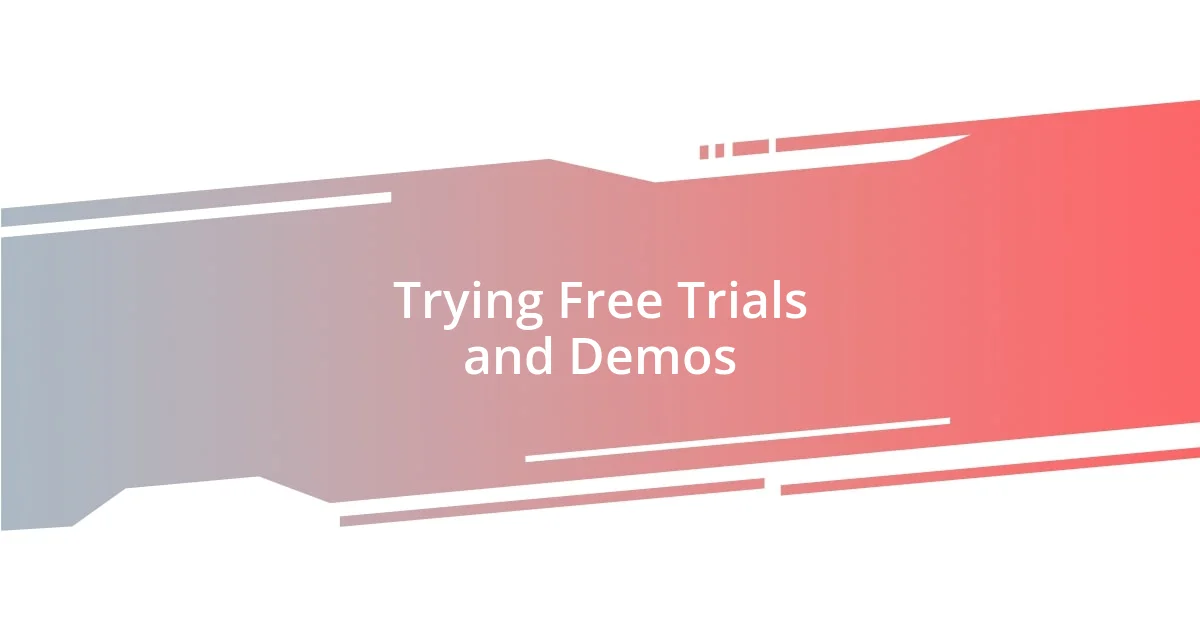
Trying Free Trials and Demos
Trying free trials and demos has been a cornerstone of my decision-making process when selecting art software. I vividly recall downloading a demo version of a highly-rated graphic design tool, eager to explore its features. To my surprise, the interface felt incredibly intuitive, and I found myself jumping into a project as if I had been using it for years. Have you ever felt that spark when the right tool seems to understand your creative flow? It’s a beautiful moment that can shape your artistic journey.
While some demos left me feeling underwhelmed, others opened doors to new possibilities. There was one instance where I tried out a sketching application that promised to replicate the feeling of pencil on paper. My heart raced as I sketched my first few lines; the smoothness and responsiveness were like meeting an old friend after years apart. However, I remember the palpable disappointment in the pit of my stomach when the trial expired. That experience taught me the value of truly engaging with a program before committing.
I usually take notes during these trials, jotting down features I love and any frustrations I encounter. I remember testing an animation software that boasted an impressive array of effects, but the learning curve was steep. I found myself questioning if the end product would be worth the effort. Through each trial, I’ve discovered that what feels like a hurdle today can lead to mastery tomorrow. Have you had similar experiences where the initial struggle turned into a profound skill? Diving into free trials not only helps in evaluating software compatibility but also in understanding your own preferences and creative process.
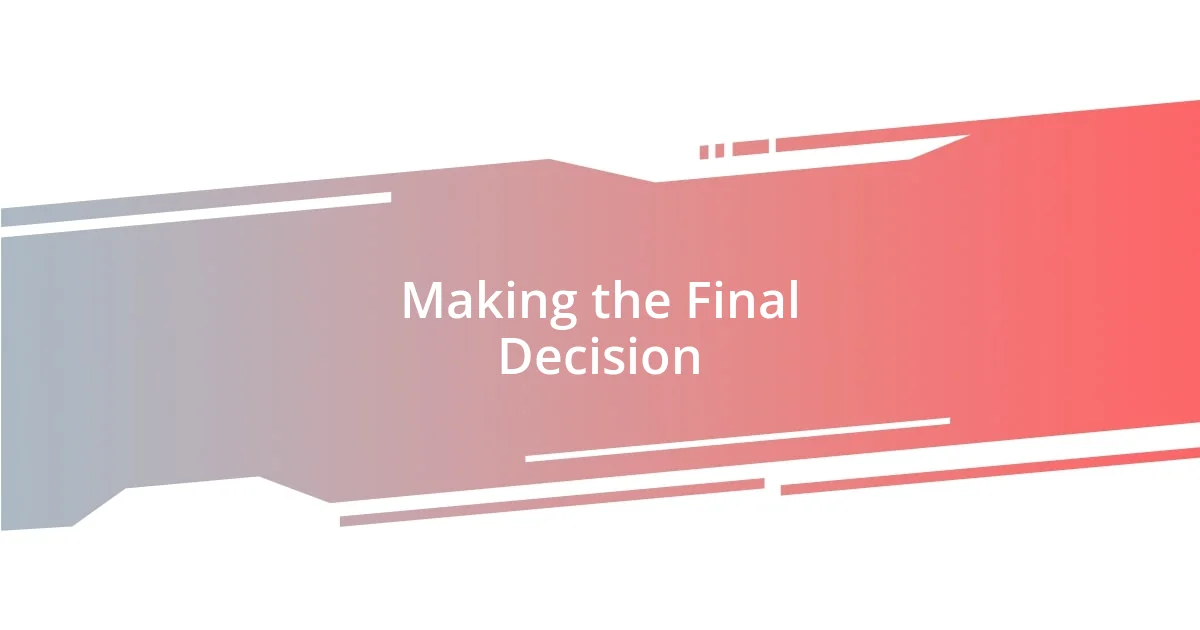
Making the Final Decision
When it came time to make my final decision on art software, I found myself reflecting back on all the trials. I remember standing in my studio, staring at my laptop screen, feeling a mix of excitement and anxiety. Would this be the tool that transformed my artwork? After weeks of experimentation, I realized that the software I connected with the most wasn’t necessarily the most popular—it was the one that felt like an extension of my creativity.
I also considered practical aspects, like compatibility with my existing tools and budget. For instance, I faced a dilemma with two painting programs: one offered an incredible array of brushes, while the other seamlessly integrated with my favorite hardware. I had to weigh the importance of creative options against technical efficiency. This wasn’t just a purchase; it was an investment that would shape my art for years to come.
Ultimately, my decision became clear after visualizing my future projects. I asked myself, which software would inspire me to create? I remember that pivotal moment when I envisioned a series of digital landscapes. Suddenly, all my research and trials coalesced, revealing which software would not only meet my needs but ignite my passion. That moment reminded me how important it is to align software with one’s artistic vision. Do you feel inspired by the right tools, too?











